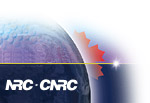Students Learn the Importance of Integrated Research
2006-05-10  | Students examine a DNA microarray, also called a DNA chip. Researchers use these chips to spot thousands of DNA probes. |
What better way to demonstrate the benefits of collaborative research than by introducing the next generation of scientists to the multi-disciplinary approach of a horizontal research program.
On March 23rd, the NRC Genomics and Health Initiative (NRC-GHI) opened its doors to 30 students from three National Capital Region high schools — Gloucester High School, École catholique Samuel Genest, and Lester B. Pearson Cathloic High School. This educational programme was designed to inform students about the genomics and health research sector and illustrate the leading role that Canada plays in these areas. Researchers from several of NRC's Life Sciences institutes came together in a coordinated effort to ensure the success of the visit, some traveling from Halifax and Montreal.
First on the agenda was an overview on genomics by Dr. John Nash from the NRC Institute for Biological Sciences (NRC-IBS). Dr. Nash set the stage for the day's activities by talking to students about genomics and how researchers decipher the genetic information contained within living organisms. Afterwards, students were divided into three groups and escorted to designated labs in the building.
Waiting in one lab to receive a group of students was Dr. André Nantel from the NRC Biotechnology Research Institute (NRC-BRI). In this portion of the tour, students learned about microarray applications and had the rare opportunity to observe a microarray spotting robot in operation and a DNA chip. They also learned that even in the field of biology, especially functional genomics, you need math and statistics to make sense of the huge data sets. In an adjacent lab, Dr. John Pezacki from the NRC Steacie Institute for Molecular Sciences (NRC-SIMS) and Dr. David Blais (NRC-GHI) spoke to students about genomic technologies. Dr. Pezacki explained how his program brings together experts from five different institutes to develop technologies that aid in the rapid and cost-effective surveillance of pathogens that are harmful to human health. Dr. Pezacki circulated an example of one such device called a "Lab on a Chip".
Not far down the hall, Dr. John Kelly (NRC- IBS), Mr. Luc Tessier (NRC-IBS) and Ms. Tammy-Lynn Tremblay (NRC-GHI) delivered a three-part presentation on proteomics. The session flowed from Ms.Tremblay's overview on the function of proteins to Dr. Kelly and Mr. Tessier's discussion and demonstration of mass spectrometry applications in research, such as examining proteins. Dr. Kelly counselled the students not only to learn biology, but also, to understand the technologies that are important to proteomics if they wish to pursue a career in the field.
In another lab, Dr. Laura Brown from the NRC Institute for Marine Biosciences (NRC-IMB) and Mr. Christian Luebbert (NRC-IBS) introduced the students to aquatic animal diseases. The presentation was tailored for the high school audience, with a DNA extraction demonstration by Anne Bouevitch (NRC-GHI), and a descriptive video of a surgical procedure used to perform in vivo culture experiments.  | Mr. Gary Fudge, Director (Acting), GHI Coordination Office, NRC Genomics and Health Initiative congratulates a student who scored top marks on the pop quiz. |
The session wrapped-up with a lunch in the library where researchers, teachers, and students were able to interact following the morning's activities. Students also completed a quiz that tested their knowledge on what they had learned during their visit. The top scoring students from each school where presented with a NRC memento – a nice way to end the day. Back to News |

